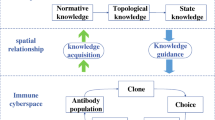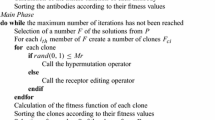Abstract
Clustering is an important tool in data mining process. Fuzzy \(c\)-means is one of the most classic methods. But it has been criticized that it is sensitive to the initial cluster centers and is easy to fall into a local optimum. Not depending on the selection of the initial population, evolutionary algorithm is used to solve the problems existed in original fuzzy \(c\)-means algorithm. However, evolutionary algorithm emphasizes the competition in the population. But in the real world, the evolution of biological population is not only the result of internal competition, but also the result of mutual competition and cooperation among different populations. Co-evolutionary algorithm is an emerging branch of evolutionary algorithm. It focuses on the internal competition, while on the cooperation among populations. This is more close to the process of natural biological evolution and co-evolutionary algorithm is a more excellent bionic algorithm. An immune clustering algorithm based on co-evolution is proposed in this paper. First, the clonal selection method is used to achieve the competition within population to reconstruct each population. The internal evolution of each population is completed during this process. Second, co-evolution operation is conducted to realize the information exchange among populations. Finally, the iteration results are compared with the global best individuals, with a strategy called elitist preservation, to find out the individual with a highest fitness value, that is, the result of clustering. Compared with four state-of-art algorithms, the experimental results indicate that the proposed algorithm outperforms other algorithms on the test data in the highest accuracy and average accuracy.






Similar content being viewed by others
Explore related subjects
Discover the latest articles, news and stories from top researchers in related subjects.References
Agrawal R, Gehrke J, Gunopolos D (1998) Automatic subspace clustering of high dimensional data for data mining applications [C]. In: Proceedings of ACM SIGMOD international conference on management of data. ACM Press, New York, pp 94–105
Ahmad W, Narayanan A (2011) Population-based artificial immune system clustering algorithm [M]. In: Artificial immune systems, pp 348–360
Al-Muallim MT, El-Kouatly R (2010) Unsupervised classification using immune algorithm [J]. Int J Comput Appl 2(7):44–48
Ankerst M, Breunig MM, Kriegel HP, Sander J (1999) OPTICS: ordering points to identify the clustering structure [C]. In: Proceedings of SIGMOD. ACM Press, New York, pp 49–60
Burnet MF (1957) A modification of Jernecs theory of antibody production using the concept of clonal election [J]. Austr J Sci 20(1):67–76
Chen YW, Huang L, Luo WM et al (2008) A dynamic clonal selection immune clustering algorithm[C]. In: 30th annual international conference of the IEEE. Engineering in Medicine and Biology Society, pp 1048–1051
De Castro LN, Von Zuben FJ (2000) The clonal selection algorithm with engineering applications. In: Proceedings of GECCO, workshop on artificial immune systems and their applications, pp 36–37
Deng ZH, Chung FL, Wang ST (2008) FRSDE: fast reduced set density estimator using minimal enclosing ball [J]. Pattern Recognit 41(4):1363–1372
Dunn JC (1973) A fuzzy relative of the ISODATA process and its use in detecting compact, well-separated clusters [J]. J Cybern 3(3):32–57
Du HF, Jiao LCH (2002) Clonal operator antibody clone algorithms. In: Proceedings of 2002 international conference on machine learning and cybernetics, vol 1, pp 506–510
Eghbal G, Mansoori (2013) GACH: a grid-based algorithm for hierarchical clustering of high-dimensional data. Soft Comput. doi:10.1007/s00500-013-1105-8
Ester M, Kriegel HP, Sander J, Xu XW (1996) A density-based algorithm for discovering clusters in large spatial databases with noise [C]. In: Proceedings of the 2nd international conference on knowledge discovering in databases and data mining. AAAI Press, pp 122–128
Ficici SG, Pollack JB (2000) A game-theoretic approach to the simple coevolutionary algorithm. PPSN, pp 467–476
Frey BJ, Dueck D (2007) Clustering by passing messages between data points. Science 315(5814):972–976
Gao C, Pedrycz W, Miao DQ (2013) Rough subspace-based clustering ensemble for categorical data. Soft Comput 17:1643–1658
Girolami M, He C (2003) Probability density estimation from optimally condensed data samples [J]. Trans Pattern Anal Mach Intell 25(10):1253–1264
Guha S, Rastogi R, Shim K (1998) Cure: an efficient clustering algorithm for large database [C]. In: Proceedings of the 1996 ACM SIGMOD international conference on management of data. ACM Press, New York, pp 73–84
Higham DJ, Kibble M (2004) A unified view of spectral clustering [R]. Department of Mathematics, University of Strathclyde, England
Hoppner F, Klawonn F, Kruse R, Runkler T (1999) Fuzzy cluster analysis [M]. Wiley, New York. http://archive.ics.uci.edu/ml/datasets.html
Jazen DH (1980) When is it co-evolution. Evolution 34:6118612
Jiao LC, Liu J, Zhong WC (2012) Coevolutionary computation and multiagent systems. WIT Press, UK
Jiang B, Wang N (2013) Cooperative bare-bone particle swarm optimization for data clustering. Soft Comput. doi:10.1007/s00500-013-1128-1
Kim J, Bentley PJ (2002) Towards an artificial immune system for network intrusion detection: an investigation of dynamic clonal selection. In: Proceedings of congress on evolutionary computation, pp 1015–1020
Kohonen T (1982) Self-organized formation of topologically correct feature maps [J]. Biol Cybern 43(1):59–69
Kotinis M (2013) Improving a multi-objective differential evolution optimizer using fuzzy adaptation and K-medoids clustering. Soft Comput. doi:10.1007/s00500-013-1086-7
Lee C, Zaïane O, Park H et al (2008) Clustering high dimensional data: a graph-based relaxed optimization approach [J]. Inf Sci 178:4501–4511
Lee D, Seung H (1999) Learning the parts of objects by nonnegative matrix factorization. Nature 401:788–791
Lin KW, Lin CH, Hsiao CY (2013) parallel and scalable CAST-based clustering algorithm on GPU. Soft Comput. doi:10.1007/s00500-013-1074-y
Lillesand T, Keifer R (1994) Remote sensing and image interpretation. Wiley, Hoboken
Liu RC, D HF, Jiao LC (2003) Immunity clonal strategies. In: ICCIMA, pp 290–295
Liu RC, Zhang XR, Yang N, Lei Q, Jiao LC (2012) Immunodomaince based clonal selection clustering algorithm. Appl. Soft Comput 12(1):302–312
Meila M, Xu L (2004) Multiway cuts and spectral clustering [R]. Department of Statistics, University of Washington, USA
Mézard M (2007) Where are the exemplars? Comput Sci 315(5814):949–951
Potter MA, De Jong KA (1994) A cooperative coevolutionary approach to function optimization. In: Proceedings of the international conference on evolutionary computation and the 3rd conference on parallel problem solving from nature, Jerusalem, Israel, pp 249–257
Potter MA, De Jong KA (1995) Evolving neural networks with collaborative species. In: Proceedings of the sixth international conference on genetic algorithms, pp 340–345
Potter MA, De Jong KA (1998) The coevolution of antibodies for concept learning. Evolut Comput 6(2):32–42
Potter MA, De Jong KA (2000) Cooperative co-evolutionary: an architecture for evolving co-adapted sub-components. Evolut Comput 8(1):1–29
Powers ST, Watson RA (2007) Preliminary investigations into the evolution of cooperative strategies in a minimally spatial model. In: GECCO, p 343
Rao MR (1971) Cluster analysis and mathematical programming. J Am Stat Assoc 66(335):622–626
Sheikholeslami G, Chatterjee S, Zhang A (1998) WaveCluster: a multi-resolution clustering approach for very large spatial databases [C]. In: Proceedings of the 24th VLDB conference. Morgan Kaufmann, pp 428–439
Wang W, Yang J, Muntz R. STING (1997) A statistical information grid approach to spatial data mining [C]. In: Proceedings of the 23rd VLDB conference. Morgan Kaufmann, pp 186–195
Zhang T, Ramakrishnan R, Livny M (1996) An efficient data clustering method for very large databases [C]. In: Proceedings of the 1996 ACM SIGMOD international conference on management of data. ACM Press, New York, pp 103–114
Zhong YF, Zhang LP (2011) A new fuzzy clustering algorithm based on clonal selection for land cover classification [J]. Math Probl Eng 2011:1–21. doi:10.1155/2011/708459
Zhong YF, Zhang LP (2012) An adaptive artificial immune network for supervised classification of multi/hyper-spectral remote sensing imagery. J IEEE Trans Geosci Remote Sens 50(3):894–909
Acknowledgments
We would like to express our sincere appreciation to the anonymous reviewers for their insightful comments, which have greatly helped us in improving the quality of the paper. This work was partially supported by the National Natural Science Foundation of China, under Grants 61371201 and 61272279, the EU FP7 project (Grant No. 247619) on “NICaiA: Nature Inspired Computation and its Applications”, and the Program for Cheung Kong Scholars and Innovative Research Team in University under Grant IRT1170.
Author information
Authors and Affiliations
Corresponding author
Additional information
Communicated by V. Loia.
Rights and permissions
About this article
Cite this article
Shang, R., Li, Y. & Jiao, L. Co-evolution-based immune clonal algorithm for clustering. Soft Comput 20, 1503–1519 (2016). https://doi.org/10.1007/s00500-015-1602-z
Published:
Issue Date:
DOI: https://doi.org/10.1007/s00500-015-1602-z




